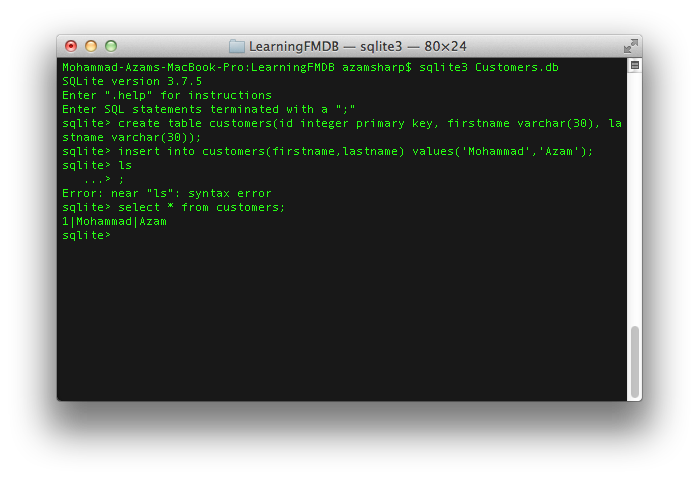

- READING AND WRITING DATA IN DB SQLITE IOS INSTALL
- READING AND WRITING DATA IN DB SQLITE IOS FOR ANDROID
- READING AND WRITING DATA IN DB SQLITE IOS ANDROID
- READING AND WRITING DATA IN DB SQLITE IOS CODE
Create: The connection will automatically create the database file if it doesn't exist.The SQLiteOpenFlag enum supports these values: In this example, the constants file specifies default SQLiteOpenFlag enum values that are used to initialize the database connection. Path.Combine(FileSystem.AppDataDirectory, DatabaseFilename) create the database if it doesn't exist Public const SQLite.SQLiteOpenFlags Flags = Public const string DatabaseFilename = "TodoSQLite.db3" The sample project includes a Constants.cs file that provides common configuration data: public static class Constants
READING AND WRITING DATA IN DB SQLITE IOS INSTALL
In addition to sqlite-net-pcl, you temporarily need to install the underlying dependency that exposes SQLite on each platform:Ĭonfiguration data, such as database filename and path, can be stored as constants in your app.


READING AND WRITING DATA IN DB SQLITE IOS ANDROID
Android frontend is currently in the middle of removing the dependency on the Gecko-side store, resulting in a set of login tables inside browser.db, but the work is as yet incomplete. signons.sqlite used to be used on desktop too, but they were migrated into logins.json. Android uses a SQLite database, signons.sqlite, for storing logins. iOS keeps logins as a separate SQLite database, logins.db, that uses sqlcipher for encryption.
READING AND WRITING DATA IN DB SQLITE IOS CODE
The front-end code uses specific, narrow, safe APIs to read and write data, and storage manages sync metadata. iOS has very strong encapsulation of storage. The exception to this is the reading list store which is defined separately from the others. iOS stores are not especially well documented, but the schemas are defined in a database specific files which makes discovering the schemas trivial. It also writes credential information to the iOS keychain. iOS uses 3 different storage formats, SQLite, JSON and plist. Due to a change in strategy, this store is no longer in use. metadata.db was created to store metadata for use in Activity Stream and was created separately to make syncing of this data at a later data easier.
READING AND WRITING DATA IN DB SQLITE IOS FOR ANDROID
Firefox for Android Java frontend uses 3 stores.Very few of these stores are well documented in the code. Within these 46 stores, there are at least 10 different storage formats. There are a total of 46 separate data stores in Firefox for desktop.The extensive documentation can be found in the Firefox Data Stores repository. We therefore need to look at all of the data stores that we are currently using and document their purpose, structure, the kind of data that they hold and how they share that data. When starting to think about how we might provide a holistic user data solution for Mozilla, it is important to understand the scope of the problem and the specifics of the data that is being handled. But not all the information is synced completely across all platforms, and the data itself is not stored in the same way everywhere. We have 3 platforms, desktop, Android and iOS and each of these platforms shares data with the others. There is currently nowhere that documents all these data stores and how they share information between them. There are a large number of data stores being used to hold data across all Firefox instances and platforms.


 0 kommentar(er)
0 kommentar(er)
